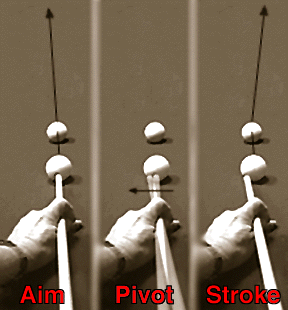Hit Accuracy
| by Jim Meador
The bridge is a critical part of the game that should receive constant attention during practice. It is much more than a cradle for the shaft. The bridge is also a fulcrum that inversely mirrors the motion of the butt by a factor related to the length of the bridge (the distance between the cueball at contact, and your bridge.) The longer the bridge the more the tip will reflect the motion of the butt, good and bad. A well educated stroke is one that moves the tip smoothly through the cueball in the direction of the object ball, with a minimum of lateral motion. A good bridge, in harmony with a well controlled pendulum stroke and follow-through, will reduce the number of poor hits on the cueball that otherwise create throw, tip deflection or "squirt".
Increasing Accuracy Tip Control
Once a player has reached the intermediate stage, I believe the hit on the cueball is the most important factor in the game. Control in this area is what separates the advanced from the expert shooters. Although many pros have developed all kinds of strange strokes to perform wizardry with the cueball, including strokes that pivot across the "fulcrum", control is still the key. In golf, a slice or hook is often the result of poor control by a beginner. When a pro executes a hook or slice, it is probably a sign of precise control: it is a question of intent. In pool, both poor and advanced shooters can make the cueball curve, but what was the intent?
Poor hits on the cueball may be more responsible for missed shots than poor aim. But many players, fail to see why they missed, and end up trying to fix the wrong thing. The aim can be perfect, while a poor stroke causes the cueball to diverge off the intended path. There is little point in trying to develop flawless aiming techniques if the stroke is wild.

If a stick is 60 inches long, and the length if the bridge is 6 inches, the bridge is 10 percent of the total length of the cue stick, which leaves 54 inches, or 90% of the total length from the bridge to the end of the butt. The pivot ratio will be 1/9. So, if the end of butt moves up and down or side to side 9 inches, the tip will move 1 inch. If the butt moves 2 inches, the tip (with a 6" bridge) pivots approximately 1/4".
While 1/4" may not seem like much, it represents approximately 1/2 tip off center (the most popular tip width is 13mm), and that can produce enough spin throw to send the object ball a couple inches off the intended path to the pocket on long shots.
Many very strong players use the "aim and pivot" method of applying side spin to the cueball. Their practice strokes (aligning the tip) may be on the center of the cueball, but on the final stroke they move the butt of the cue stick left or right to execute an off center hit. I see no problem with this method of stroking if it is an acquired technique resulting from years of play and practice. But students should learn to move their entire bridge hand the necessary amount left or right to apply side spin, and keep the stroke as straight on the aiming path as possible.
Pictured above is the "aim & pivot" shot. Unintended, it is the cause for many misses. But many expert shooters use the method, and some don't even know it. It is one of those acquired strokes that instructors warn against. The "pivot" takes place mid-stroke, after the shot has been lined up. Success depends entirely on "feel", and pivot shooters are rarely consistent, although when they are on they may be hard to beat. As Harry Crabtree told me when he saw me using it: "you can't take it to the bank." So consider the method as something to be avoided. Keep your stroke straight and smooth, and in line with the path to the aiming point.
Most Popular
Jackass Shooting Pool
Syndrome
Physics of Pool
Bumper Pool
The Masse'
Snooker
Topless Sharking
Selecting a Cue Stick
Long and Straight
Trick Shots
Aiming
We Recommend







